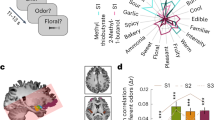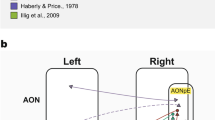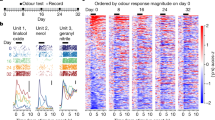Abstract
Central to the concept of attention is the fact that identical stimuli can be processed in different ways. In olfaction, attention may designate the identical flow of air through the nose as either respiration or olfactory exploration. Here we have used functional magnetic resonance imaging (fMRI) to probe this attentional mechanism in primary olfactory cortex (POC). We report a dissociation in POC that revealed attention-dependent and attention-independent subregions. Whereas a temporal subregion comprising temporal piriform cortex (PirT) responded equally across conditions, a frontal subregion comprising frontal piriform cortex (PirF) and the olfactory tubercle responded preferentially to attended sniffs as opposed to unattended sniffs. In addition, a task-specific anticipatory response occurred in the attention-dependent region only. This dissociation was consistent across two experimental designs: one focusing on sniffs of clean air, the other focusing on odor-laden sniffs. Our findings highlight the role of attention at the earliest cortical levels of olfactory processing.
This is a preview of subscription content, access via your institution
Access options
Subscribe to this journal
Receive 12 print issues and online access
$209.00 per year
only $17.42 per issue
Buy this article
- Purchase on Springer Link
- Instant access to full article PDF
Prices may be subject to local taxes which are calculated during checkout






Similar content being viewed by others
References
Price, J.L. Olfactory system. in The Human Nervous System (ed. Paxinos, G.) 979–1001 (Academic, San Diego, 1990).
Carmichael, S.T., Clugnet, M.C. & Price, J.L. Central olfactory connections in the macaque monkey. J. Comp. Neurol. 346, 403–434 (1994).
Adrian, E.D. Olfactory reactions in the brain of the hedgehog. J. Physiol. (Lond.) 100, 459–473 (1942).
Macrides, F. & Chorover, S.L. Olfactory bulb units: activity correlated with inhalation cycles and odor quality. Science 175, 84–87 (1972).
Fontanini, A., Spano, P. & Bower, J.M. Ketamine-xylazine-induced slow (<1.5 Hz) oscillations in the rat piriform (olfactory) cortex are functionally correlated with respiration. J. Neurosci. 23, 7993–8001 (2003).
Sobel, N. et al. Sniffing and smelling: separate subsystems in the human olfactory cortex. Nature 392, 282–286 (1998).
Haberly, L.B. Parallel-distributed processing in olfactory cortex: new insights from morphological and physiological analysis of neuronal circuitry. Chem. Senses 26, 551–576 (2001).
Gottfried, J.A., Deichmann, R., Winston, J.S. & Dolan, R.J. Functional heterogeneity in human olfactory cortex: an event-related functional magnetic resonance imaging study. J. Neurosci. 22, 10819–10828 (2002).
Litaudon, P., Amat, C., Bertrand, B., Vigouroux, M. & Buonviso, N. Piriform cortex functional heterogeneity revealed by cellular responses to odours. Eur. J. Neurosci. 17, 2457–2461 (2003).
Mai, J., Assheuer, J. & Paxinos, G. Atlas of the Human Brain (Academic, London, 1997).
Savic, I. Imaging of brain activation by odorants in humans. Curr. Opin. Neurobiol. 12, 455–461 (2002).
Courchesne, E. & Allen, G. Prediction and preparation, fundamental functions of the cerebellum. Learn Mem. 4, 1–35 (1997).
Spence, C., McGlone, F.P., Kettenmann, B. & Kobal, G. Attention to olfaction. A psychophysical investigation. Exp. Brain Res. 138, 432–437 (2001).
Spence, C., Kettenmann, B., Kobal, G. & McGlone, F.P. Selective attention to the chemosensory modality. Percept. Psychophys. 62, 1265–1271 (2000).
Geisler, M.W. & Murphy, C. Event-related brain potentials to attended and ignored olfactory and trigeminal stimuli. Int. J. Psychophysiol. 37, 309–315 (2000).
Krauel, K., Pause, B.M., Sojka, B., Schott, P. & Ferstl, R. Attentional modulation of central odor processing. Chem. Senses 23, 423–432 (1998).
O'Doherty, J. et al. Sensory-specific satiety-related olfactory activation of the human orbitofrontal cortex. NeuroReport 11, 893–897 (2000).
Gottfried, J.A., O'Doherty, J. & Dolan, R.J. Encoding predictive reward value in human amygdala and orbitofrontal cortex. Science 301, 1104–1107 (2003).
Tootell, R.B. et al. The retinotopy of visual spatial attention. Neuron 21, 1409–1422 (1998).
Gandhi, S.P., Heeger, D.J. & Boynton, G.M. Spatial attention affects brain activity in human primary visual cortex. Proc. Natl. Acad. Sci. USA 96, 3314–3319 (1999).
Kanwisher, N. & Wojciulik, E. Visual attention: insights from brain imaging. Nat. Rev. Neurosci. 1, 91–100 (2000).
Pugh, K.R. et al. Auditory selective attention: an fMRI investigation. NeuroImage 4, 159–173 (1996).
Petkov, C.I. et al. Attentional modulation of human auditory cortex. Nat. Neurosci. 7, 658–663 (2004).
Carlsson, K., Petrovic, P., Skare, S., Petersson, K.M. & Ingvar, M. Tickling expectations: neural processing in anticipation of a sensory stimulus. J. Cogn. Neurosci. 12, 691–703 (2000).
Schoenbaum, G. & Eichenbaum, H. Information coding in the rodent prefrontal cortex. I. Single-neuron activity in orbitofrontal cortex compared with that in pyriform cortex. J. Neurophysiol. 74, 733–750 (1995).
Zinyuk, L.E., Datiche, F. & Cattarelli, M. Cell activity in the anterior piriform cortex during an olfactory learning in the rat. Behav. Brain Res. 124, 29–32 (2001).
Kay, L.M. & Freeman, W.J. Bidirectional processing in the olfactory-limbic axis during olfactory behavior. Behav. Neurosci. 112, 541–553 (1998).
Gray, C.M. & Skinner, J.E. Centrifugal regulation of neuronal activity in the olfactory bulb of the waking rabbit as revealed by reversible cryogenic blockade. Exp. Brain Res. 69, 378–386 (1988).
O'Connor, D.H., Fukui, M.M., Pinsk, M.A. & Kastner, S. Attention modulates responses in the human lateral geniculate nucleus. Nat. Neurosci. 5, 1203–1209 (2002).
Yu, Y.Q., Xiong, Y., Chan, Y.S. & He, J. Corticofugal gating of auditory information in the thalamus: an in vivo intracellular recording study. J. Neurosci. 24, 3060–3069 (2004).
Logothetis, N.K., Pauls, J., Augath, M., Trinath, T. & Oeltermann, A. Neurophysiological investigation of the basis of the fMRI signal. Nature 412, 150–157 (2001).
Kay, L.M. & Laurent, G. Odor- and context-dependent modulation of mitral cell activity in behaving rats. Nat. Neurosci. 2, 1003–1009 (1999).
Bressler, S.L. Relation of olfactory bulb and cortex. II. Model for driving of cortex by bulb. Brain Res. 409, 294–301 (1987).
Sobel, N. et al. Time course of odorant-induced activation in the human primary olfactory cortex. J. Neurophysiol. 83, 537–551 (2000).
Kareken, D.A. et al. Olfactory system activation from sniffing: effects in piriform and orbitofrontal cortex. NeuroImage 22, 456–465 (2004).
Wilson, D.A. Rapid, experience-induced enhancement in odorant discrimination by anterior piriform cortex neurons. J. Neurophysiol. 90, 65–72 (2003).
Johnson, B.N., Mainland, J.D. & Sobel, N. Rapid olfactory processing implicates subcortical control of an olfactomotor system. J. Neurophysiol. 90, 1084–1094 (2003).
Wilson, J.L., Jenkinson, M. & Jezzard, P. Optimization of static field homogeneity in human brain using diamagnetic passive shims. Magn. Reson. Med. 48, 906–914 (2002).
Engel, S.A. et al. fMRI of human visual cortex. Nature 369, 525 (1994).
Boynton, G.M., Engel, S.A., Glover, G.H. & Heeger, D.J. Linear systems analysis of functional magnetic resonance imaging in human V1. J. Neurosci. 16, 4207–4221 (1996).
Polonsky, A., Blake, R., Braun, J. & Heeger, D.J. Neuronal activity in human primary visual cortex correlates with perception during binocular rivalry. Nat. Neurosci. 3, 1153–1159 (2000).
Wandell, B.A. & Wade, A.R. Functional imaging of the visual pathways. Neurol. Clin. 21, 417–443 (2003).
Efron, B. & Tibshirani, R. An Introduction to the Bootstrap (Chapman and Hall, London, 1993).
Bullmore, E. et al. How good is good enough in path analysis of fMRI data? NeuroImage 11, 289–301 (2000).
Acknowledgements
We thank Arak Elite. This work was supported by a grant from the National Institute of Deafness and Communication Disorders (R01 DC005958). C.Z. is supported by a predoctoral fellowship from the National Science Foundation.
Author information
Authors and Affiliations
Corresponding authors
Ethics declarations
Competing interests
The authors declare no competing financial interests.
Supplementary information
Supplementary Fig. 1
An example of the progression of the piriform ROI from the anterior commisure and six slices forward. (PDF 4778 kb)
Supplementary Fig. 2
The rules for delineating the structural ROIs. To separate PirF from the olfactory tubercle, we drew a vertical line on the coronal image at the medial border of the uncus, and this line split PirF from TU at its dorsal intersection (line A). To separate between the temporal (PirT) and frontal (PirF) portions of piriform, for each subject we drew a line on the coronal image, at the limen insulae (line B). (PDF 1222 kb)
Supplementary Fig. 3
This figure shows a relation of nasal airflow to MR signal. It shows that differences in nasal airflow across conditions were not reflected in the differing activity across conditions, thus alleviating concerns of airflow. (PDF 191 kb)
Supplementary Fig. 4
FMRI derived Latency differences in BOLD response. This figure shows the mean relative latencies of the BOLD responses of the 3 POC sub-regions. For each condition for each subject, the latency of each trial was calculated as the time from odor onset to peak response. Latency values are shown in units of TR. One TR is 0.5 seconds. Error bars indicate standard error of the mean. There were significantly different latency values across conditions in PirT and PirF (PirT: F(978) = 6.49, p < .0002; PirF: F(978) = 4.17, p < .0061) but not in Tu (F(978) = 1.97, p < 0.1162). As for regional differences, the only significant difference in latency between regions was between PirT and PirF under condition ‘Inhalation2’. The BOLD response in PirT peaked faster in response to ‘Inhalation2’ than did the BOLD response in PirF (F(438) = 4.17, p < .0417). (PDF 65 kb)
The temporal characteristics of fMRI have been explored previously by looking at both time to peak and at the inflection point of the initial BOLD response from baseline (Formisano et al 2002, Menon et al 1998). In both cases, the feasibility of addressing some functional questions in terms of chronometry of human brain functions was confirmed. Although this study was not specifically designed for the purpose of examining temporal aspects of the BOLD signal, differences were observed across conditions. We found that within PirT and PirF, the response to condition ‘Odor’ peaked significantly later than did the response to conditions ‘NoOdor’ and ‘Inhalation2’. In addition, in PirF, condition ‘Odor’ peaked significantly later than did condition ‘Inhalation’. Finally, we observed that the response to condition inhalation2 peaked earlier in PirT than it did in PirF.
Interpretation of these results requires caution, as the exact cause of latency differences of the BOLD signal is not known. However, some speculation can be made. The finding of relatively early activation of PirT in response to ‘Inhalation2’ might implicate the region in early sensory driven processing, while the slower activation of PirF under this condition might imply that it is involved in higher order functions. The finding that condition ‘Odor’ was always the slowest condition could reflect the slow temporal patterning that has been observed in locusts and in mammals in single-cell recordings (Laurent 2002, Laurent G et al 2001, Fletcher et al 2003). These studies have observed responses to a single sniff lasting up to several seconds.
References:
G Laurent. Olfactory Network Dynamics and the Coding of Multidimensional signals. Nat Rev Neurosci. 2002 Nov;3(11):884-95.
Laurent G, Stopfer M, Friedrich RW, Rabinovich MI, Volkovskii A, Abarbanel HD. Odor encoding as an active, dynamical process: experiments, computation, and theory. Annu Rev Neurosci. 2001;24:263-97.
Max L. Fletcher and Donald A. Wilson. Olfactory Bulb Mitral-Tufted Cell Plasticity: Odorant-Specific Tuning Reflects Previous Odorant Exposure. The Journal of Neuroscience, July 30, 2003, 23(17):6946-6955.
Menon, R et al, Spatial and temporal resolution of functional magnetic resonance imaging. Biochem. Cell Biol. 76: 560-571 1998.
Formisano E et al, Tracking the mind’s image in the brain I: Time resolved fMRI during Visuospatial mental imagery. Neuron, Vol 35, 185-194, July 3, 2002.
Supplementary Fig. 5
This figure shows the mean sniff volume, max flow, mean flow, and duration for all subjects across conditions olfaction vs. audition. Sniffs did not differ significantly for the two tasks, relieving concerns of airflow effects. (PDF 299 kb)
Supplementary Methods
This section contains a detailed description of our methods. (PDF 113 kb)
Rights and permissions
About this article
Cite this article
Zelano, C., Bensafi, M., Porter, J. et al. Attentional modulation in human primary olfactory cortex. Nat Neurosci 8, 114–120 (2005). https://doi.org/10.1038/nn1368
Received:
Accepted:
Published:
Issue Date:
DOI: https://doi.org/10.1038/nn1368
This article is cited by
-
Physicochemical features partially explain olfactory crossmodal correspondences
Scientific Reports (2023)
-
Attention, please! A survey of neural attention models in deep learning
Artificial Intelligence Review (2022)
-
Acquired olfactory loss alters functional connectivity and morphology
Scientific Reports (2021)
-
Altered glucose metabolism of the olfactory-related cortices in anosmia patients with traumatic brain injury
European Archives of Oto-Rhino-Laryngology (2021)
-
Phasic dopamine reinforces distinct striatal stimulus encoding in the olfactory tubercle driving dopaminergic reward prediction
Nature Communications (2020)



